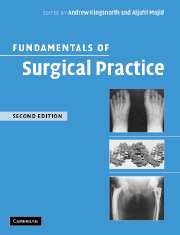Book contents
- Frontmatter
- Contents
- Preface
- Contributors
- 1 Preoperative management
- 2 Principles of anaesthesia
- 3 Postoperative management
- 4 Nutritional support
- 5 Surgical sepsis: prevention and therapy
- 6 Surgical techniques and technology
- 7 Trauma: general principles of management
- 8 Intensive care
- 9 Principles of cancer management
- 10 Ethics, legal aspects and assessment of effectiveness
- 11 Haemopoietic and lymphoreticular systems: anatomy, physiology and pathology
- 12 Upper gastrointestinal surgery
- 13 Lower gastrointestinal surgery
- 14 Hernia management
- 15 Vascular surgery
- 16 Endocrine surgery
- 17 The breast
- 18 Thoracic surgery
- 19 Genitourinary system
- 20 Head and neck
- 21 The central nervous system
- 22 Musculoskeletal system
- 23 Paediatric surgery
- Index
9 - Principles of cancer management
Published online by Cambridge University Press: 15 December 2009
- Frontmatter
- Contents
- Preface
- Contributors
- 1 Preoperative management
- 2 Principles of anaesthesia
- 3 Postoperative management
- 4 Nutritional support
- 5 Surgical sepsis: prevention and therapy
- 6 Surgical techniques and technology
- 7 Trauma: general principles of management
- 8 Intensive care
- 9 Principles of cancer management
- 10 Ethics, legal aspects and assessment of effectiveness
- 11 Haemopoietic and lymphoreticular systems: anatomy, physiology and pathology
- 12 Upper gastrointestinal surgery
- 13 Lower gastrointestinal surgery
- 14 Hernia management
- 15 Vascular surgery
- 16 Endocrine surgery
- 17 The breast
- 18 Thoracic surgery
- 19 Genitourinary system
- 20 Head and neck
- 21 The central nervous system
- 22 Musculoskeletal system
- 23 Paediatric surgery
- Index
Summary
THE GENETIC CODE
Little more than 50 years have passed since James Watson and Francis Crick reported the structure of deoxyribose nucleic acid (DNA) in an understated article in the journal Nature. This discovery ushered in a new era of discovery in the biological sciences that continues at an ever-increasing pace.
The growth and differentiation from a single fertilized ovum into a functional organism requires around 2000 proteins, many of which are enzymes that catalyse chemical reactions directly or via intermediates. Other proteins have structural roles, contribute to cell membranes, bind ions or act as hormones. Proteins consist of polypeptides chains, each built from unique sequences of 20 amino acids into chains of between 30 and 3000 amino acids (primary structure). The chains are folded into conformations containing active sites that allow allosteric interaction between enzyme and substrate. Enzymatic reactions require energy, which is supplied by the breakdown of food molecules coupled to the phosphorylating system. Unlike sugars, which are synthesized by repeating blocks of similar composition and therefore require a limited number of enzymes, proteins are uniquely irregular, each coded for by a template of DNA, which carries a specific genetic code.
DNA is composed of two strands, each with a deoxyribose sugar ‘backbone’ to which are attached sequences of two purine (adenine and guanine) and two pyrimidine (cytosine and thymidine) complementary nucleotides.
- Type
- Chapter
- Information
- Fundamentals of Surgical Practice , pp. 149 - 183Publisher: Cambridge University PressPrint publication year: 2006



